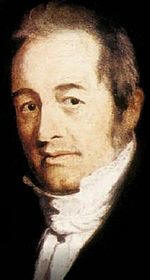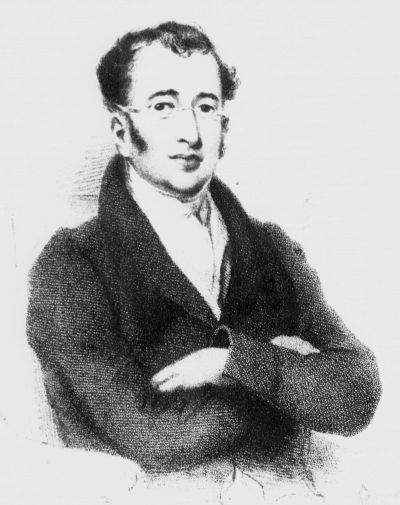|
Edited
by Frank R. Shaw, FSA Scot, Dawsonville, GA, USA
Email:
jurascot@earthlink.net
Here is an interesting
connection, slight as it may be, between Robert Burns and John Galt,
“the other great Ayrshire writer.” Were they the best of friends? No and
neither did they frequent the pubs together, but they had one thing in
common – they were distant kin being, I believe, second cousins. There
was twenty years separating them with Galt being the youngest. Because
of this age difference, there is little between the two except their
bloodline and their desire to write. One wrote books, the other a book.
One dealt in prose and the other primarily in poetry and songs. Yes, one
went to debtor’s prison while the other thought he was going there too
as he lay on his death bed. One was the son of a sea captain who told
stories around the fireplace that caused his son to go see the world for
himself as a traveler to Canada and Europe. As Chris Rollie points out
in his fine book Robert Burns in England, Burns went to England but
ventured into the country for only a few miles. One founded cities and
made good money while the other could only dream of such money -- and
none of us will ever forget him on his death bed begging for a few
pounds. One is enshrined in the hearts of men and women all over the
world and the other, by contrast, is hardly known by our world’s
population. I could go on with other comparisons, but John McGee’s
wonderful article on John Galt awaits. Enjoy.
Our writer, Ian McGhee,
or John if you prefer, was born and brought up in Ayrshire, Scotland and
has recently returned there to live. After a successful career in the
public service dealing mainly with business and industry, he enrolled at
Glasgow University to study Scottish Literature and was awarded a first
class Honours degree in 2013. He is currently completing a Masters in
John Galt's North American corpus.
I’m grateful for John’s
assistance with this article and for the several pictures he has shared,
and I also appreciate Gerry Carruthers putting the two of us together
for this piece. A new John Galt Society was just formed in Glasgow this
month with dues of only £10 annually. I jumped at the chance to join as
a means of learning more about John Galt from these scholarly Scottish
men, and I hope you will join me in membership. There is so much more to
Scotland than just Robert Burns. So please contact me and I will put you
in touch with the person in charge. (FRS: 12.18.14)
John Galt:
The Other Great Ayrshire Writer
by Ian McGee

Ian McGhee

John Galt
Robert Burns was not the
only great literary figure to emerge from Ayrshire. John Galt was only
twenty years younger than Burns but can fairly be said to have been as
innovative in prose as his more famous countryman was in poetry. Galt
anatomised the small communities of the West of Scotland at a time of
unprecedented social, religious and economic change, pioneered the
political novel, took the concept of first person narration to new
heights of irony and leavened it all with a richly comic yeast. And all
the while he considered that his writing was a poor second to his
pursuit of fame and wealth through business.
Of course it may not just
be the Ayrshire air which produces writers. The genes may have a
greater influence. David Knight, in Guelph Ontario, the city founded by
Galt, published a new edition of Galt’s story The Omen in 2014 and in
his foreword says that Galt’s father John was a first cousin to Burns
and also a first cousin to John Allan, the foster father of Edgar Allan
Poe. There is evidence, too, that Galt was a founder member of Greenock
Burns Club, the oldest in the world.
John Galt was born in
Irvine in 1779. His family moved to Greenock in 1789 and it was there
that he completed his education and first started work. In 1804 he went
to London to seek his fortune, a prize which hovered tantalisingly out
of reach for all his life. Bankrolled by his father he bought into a
partnership which went bankrupt in 1809. Discharged by his creditors he
went travelling for more than 2 years around the Mediterranean, where he
fell in with Lord Byron, and through Europe.
On his return to London
he tried his hand at a number of ventures, the most successful of which
was as a Parliamentary Agent; what we would now call a lobbyist. He was
responsible in 1819 for the successful passage of the necessary
legislation to allow completion of the Union Canal linking Edinburgh and
Glasgow and this brought him to the attention of some Canadian gentlemen
who were seeking compensation from the British Government for losses
they had suffered defending Canada from the US invasion during the war
of 1812 – 14. Galt undertook to represent them on a no-win, no-fee
basis.
He gradually discovered
that while the Government was ready to offer the Canadians lots of
sympathy it would not hand over any cash. In his researches on the
matter he did, however discover that the Government held vast amounts of
land in Upper Canada (present day Ontario) and that it was not being
usefully or profitably developed. He therefore conceived the idea of
forming a company which would buy the land wholesale, put in some basic
infrastructure, divide it into manageable lots and sell it retail to
emigrants and settlers.
Galt’s ideas on land and
community development had been refined when he made a reconnaissance
trip to Canada in 1825 and reached there via the Genessee country of New
York State where he had made a detailed study of the operations of the
Holland Land Company and the similar firm of Goran & Phelps, both of
whom impressed him greatly.
The Canada Company was
duly formed, obtained its charter from the Government and purchased over
2 million acres in Upper Canada. Galt was appointed as its first
commissioner and arrived in York (present day Toronto) in December
1826. Until he returned to London in April 1829 Galt worked tirelessly,
founding the cities of Guelph and Goderich, receiving and providing for
settlers, and selling land, sometimes accepting labour in exchange and
sometimes payment in instalments. The methods he pioneered were adopted
by the Company after he left and kept it in profitable business until it
was wound up in 1954.

John Galt's Town Plan of Guelph
The Canadian sojourn had
a much less happy outcome for Galt personally. He had made three
serious errors. The first was that he failed to ensure that the
Directors of the Company accepted that they needed a medium term
strategy. They had invested in the expectation of short term profits
while Galt always knew that it would take time for profits to be
realised. Unfortunately, he tended to believe that if something was
obvious to him it would be equally obvious to every other intelligent
person. The Directors, however, became very nervous when they saw the
amounts of cash flowing out at a much greater rate than the money coming
in.
The second error was to
make an enemy of the Provincial Government in Upper Canada, headed at
that time by General Sir Peregrine Maitland, a man ‘crammed with the pet
prejudices of religion, flag and caste’ according to the Canadian
historian Arthur Lower. As a staunch Anglican Maitland viewed the
Presbyterian Galt with suspicion and, wrongly, suspected him of
harbouring radical and democratic tendencies. His despatches to the
London Government therefore presented Galt’s activities in an
unflattering light and added to the uneasiness which the Directors were
feeling. Galt was not entirely blameless since his relations with
Maitland were characterised at best as lacking tact and at worst as
being downright arrogant.
The third mistake, and
the straw which broke the camel’s back, was that Galt was a poor
bookkeeper. The Company’s accounts in Canada were a mess as the Company
discovered when they sent a representative to Canada to inspect them.
There was no question of malfeasance or embezzlement: Galt did not
divert any funds to his own pocket. In fact, shortly after his return
to London he was imprisoned for debt. He could, and did, argue with
considerable justification that his workload was too great for him to
keep on top of all the details. Nevertheless it was sufficient excuse
for the Company to recall him to London in April 1829 and to dismiss
him.
Galt’s business career
was now effectively over and within the next three years he suffered a
series of strokes. They caused him to retire to Greenock where he lived
quietly until his death in 1839. Throughout his life, no matter what
else he was doing, Galt wrote. There was no literary genre to which he
did not turn his pen. Journalism on politics, economics and society,
histories, biographies, travel books, short stories, novels, children’s
text books, poems and plays were all published under a variety of
pseudonyms and with varying degrees of success. Inevitably, with such a
prodigious output the quality is variable but at his best he has few
equals for illustrating universal truths through the examination of
village and small town societies.
His first great literary
success came with the publication in monthly parts from March 1820 in
Blackwood’s Magazine of The Ayrshire Legatees, an epistolary novel
concerning the Pringle family’s time in London in pursuit of a legacy
and the reactions to their letters back in the home village just outside
Irvine. It was quickly published in book form in 1821 and in the same
year was followed by The Annals of the Parish, the purportedly
autobiographical account of the sixty years ministry (from 1760 to 1820)
of the Reverend Micah Balwhidder in the parish of Dalmailing (modelled
on the village of Dreghorn, again close to Irvine). In rapid succession
there came Sir Andrew Wylie of that Ilk (1822), The Provost (1822) and
The Entail (1822). The Provost is set in the Royal Burgh of Irvine and
covers the same period as The Annals. It is another of Galt’s
faux-autobiographies and is a wickedly funny and masterly study of
small-town politics through the medium of ironic self-revelation. What
it tells us about the political animal is as true today as it was then.

Pencil drawing of John Galt
All of these novels,
which Galt preferred to call ‘theoretical histories’, provide valuable
information for social historians about the effects of economic,
religious and social change in rural and small town Scotland at the
beginning of the nineteenth century. Professor Christopher Whatley has
said that it is only now that historians are catching up with Galt and
uncovering incontrovertible evidence that what he was saying about
social and economic conditions and the reactions of people to them is
undoubtedly true and not invented for literary or dramatic purposes.
Galt then published a
series of historical novels of which Ringhan Gilhaize (1823) is the most
noteworthy. It may be considered as a defence of the Covenanters, or
rigid Presbyterians, whom Galt felt had been afforded too little respect
by Sir Walter Scott in Old Mortality. He returned to change in the
social order, and comedy, with The Last of the Lairds (1826) which,
because he was preparing to go to Canada, he allowed to be published in
a heavily bowdlerised form. It was not until 1976 that Ian Gordon
produced an edition of that novel which contained what Galt actually
wrote rather than the genteel ending which Blackwood forced on it.
After Canada Galt needed
to write since it was his only source of income. Among other things he
published Lawrie Todd (1830), based on his experiences in New York State
but drawing on, for the early part, the real autobiography of Grant
Thorburn, a Scotsman who had emigrated to New York City and to whom Galt
says he paid ‘an author’s, not a publisher’s price’ for the manuscript.
This was followed by Bogle Corbet (1831) which ranges from Glasgow to
London to the West Indies and, for the final third of the book,
Ontario. Both of these novels have their longeurs for they were padded
out to meet the publisher’s demand for a full three volumes but they
contain fascinating accounts of Galt’s views on emigration and community
building.
The best of his later
novels is The Member (1832), another faux-autobiography concerning
Parliamentary politics before the Great Reform Act of that year widened
the franchise. It is a pioneering novel of politics, written from
Galt’s extensive experience of how Parliament actually worked as opposed
to how it presented itself, and foreshadowed what Trollope did in the
Palliser novels in the second half of the nineteenth century.
A man who was such a
master of irony in his novels was the victim of it in his life. He
said that ‘I have ever held literature to be a secondary pursuit’ and
that ‘I have sometimes felt a little shame-faced in thinking myself so
much an author…A mere literary man – an author by profession – stands
but low in my opinion’. He had failed as a businessman and was
unappreciated at the time as a community builder but as a writer of
social realism, psychological insight and high (and low) comedy he has
few equals.
END
See also our page for him
at
http://www.electricscotland.com/history/other/johngalt.htm
|

